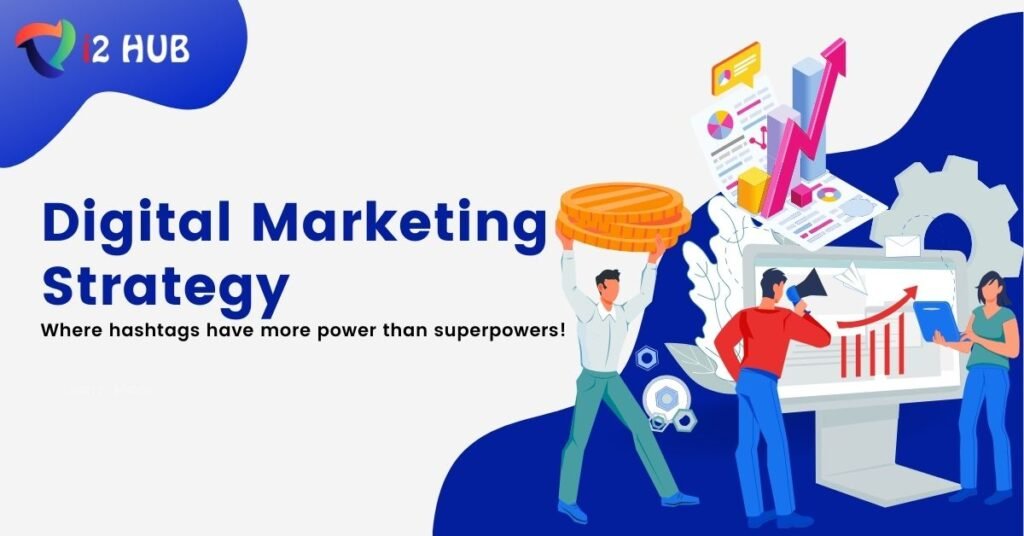A digital marketing strategy is a plan for how a business will use the internet to reach its goals. And this includes using various websites and online tools to connect with people, build brand awareness, attract visitors, find new customers, and boost sales. Key parts of digital marketing strategies are search engine optimization (SEO) to appear at the top of Google search results, content marketing to create engaging articles and videos, social media marketing to interact on platforms like Facebook and Instagram.
Email marketing to keep people informed, pay-per-click (PPC) advertising to place paid ads, influencer marketing to work with popular online personalities, and affiliate marketing to partner with others who promote the products. All these elements work together to help the business grow online.
Key Components of Digital Marketing Strategies Include

1. Objectives and Goals
Setting clear, measurable goals that align with the business’s overall objectives is crucial for an effective digital marketing strategy. These goals provide direction and a basis for gauging success. Here’s a simplified explanation of each goal, along with key digital marketing tactics to achieve them:
a. Increasing Website Traffic:
Attract more visitors to the website for greater exposure and conversion opportunities.
- SEO: Optimize content and structure to rank higher in search results.
- Content Marketing: Create valuable content to draw in the target audience.
- Social Media Marketing: Promote content on social platforms.
- PPC Advertising: Use paid search campaigns to drive targeted traffic.
b. Improving Conversion Rates:
Increase the percentage of visitors who complete desired actions.
- Landing Page Optimization: Design user-friendly, appealing pages with clear CTAs.
- A/B Testing: Test different elements to see what converts best.
- Email Marketing: Send personalized, targeted campaigns.
- Remarketing: Re-engage previous visitors with ads.
c. Generating Leads:
Acquire contact information from potential customers.
- Content Marketing: Offer resources like eBooks and webinars in exchange for contact info.
- Lead Magnets: Use discounts or exclusive content to gather leads.
- Social Media Advertising: Run targeted lead generation ads.
- Email Marketing: Capture and nurture leads through email campaigns
2. Target Audience
Identifying and understanding the target audience, including their demographics, interests, online behaviors, and pain points. This helps tailor marketing efforts to resonate with the right people.
3.Market Research and Competitor Analysis
Conducting research to understand the market landscape and analyze competitors. This helps identify opportunities, threats, and best practices within the industry.
4. Digital Channels and Tactics
Selecting the appropriate digital channels to reach the target audience. Common channels in digital marketing strategies include
- Search Engine Optimization (SEO): Making your website more visible on search engines so more people can find it.
- Content Marketing: Sharing helpful and interesting content to get people interested in your business.
- Social Media Marketing: Using sites like Facebook, Instagram, and Twitter to talk to people and share cool stuff about your business.
- Email Marketing: Sending special emails to keep in touch with customers and tell them about new stuff.
- Pay-Per-Click Advertising (PPC): Paying to put ads online to get more people to visit your website.
- Influencer Marketing: Working with popular people online to tell others about your business.
5. Content Strategy
Planning the creation, publication, and management of content that aligns with the audience’s interests and the business’s goals. This includes blog posts, videos, infographics, podcasts, and more. To read more
a. Content Creation:
- Blog Posts: Write informative and engaging articles that provide value, answer questions, and solve problems for the audience.
- Videos: Produce videos, such as tutorials, product demos, and customer testimonials, to capture attention and convey messages visually.
- Infographics: Create visually appealing infographics that present data and information in an easy-to-digest format.
- Podcasts: Record podcasts to share insights, interviews, and discussions on relevant topics, catering to audiences who prefer audio content.
b. Content Publication:
Strategically timing and distributing content to maximize reach and engagement.
- Content Calendar: Plan and schedule content releases to ensure consistency and optimal timing.
- SEO Optimization: Optimize content with relevant keywords to improve search engine visibility and attract organic traffic.
- Social Media Sharing: Promote content across social media platforms to drive traffic and engagement.
- Email Newsletters: Share content with subscribers to keep them informed and engaged.
c. Content Management:
Continuously monitoring, updating, and analyzing content to ensure it remains relevant and effective.
- Content Audit: Regularly review existing content to identify gaps, update outdated information, and improve underperforming pieces.
- Analytics and Performance Tracking: Use tools like Google Analytics to measure the performance of content and gain insights into what works best.
- User Feedback: Gather feedback from the audience to understand their preferences and improve future content.
- Repurposing Content: Adapt and reuse high-performing content in different formats to reach a broader audience.
6. Budget and Resources
Allocating a budget and determining the resources needed to implement the strategy, including personnel, tools, and technology.
7. Implementation Plan
Developing a detailed timeline and action plan for executing the strategy, including assigning responsibilities and setting deadlines.
8. Measurement and Analytics
Setting key performance indicators (KPIs) and using analytics tools to track and measure the strategy’s effectiveness is important. For example, monitoring website traffic, conversion rates, engagement metrics, and ROI helps businesses see how well their strategy is working. This way, they can make necessary improvements.
9. Optimization and Iteration
Continuously analyzing performance data and making data-driven adjustments to improve the strategy is essential. This ongoing process ensures that the strategy evolves and stays effective in achieving its goals.
A successful digital marketing strategy needs a good understanding of the internet, creative ideas, and the ability to keep up with new trends and technologies. These Digital Marketing Strategies help businesses connect with their target audiences, build brand awareness, drive traffic, generate leads, and boost sales and revenue. By using these digital Marketing strategies well, businesses can reach their marketing and business goals in the digital age.

